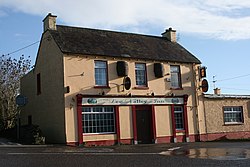Dripsey
| Dripsey Irish: Druipseach | |
| County Cork | |
|---|---|
 Pub in Dripsey | |
| Location | |
| Grid reference: | W 490739 |
| Location: | 51°54’53"N, 8°44’32"W |
| Data | |
| Local Government | |
Dripsey is a village in County Cork on the R618 road around twelve miles west of the City of Cork, beside on a tributary of the River Lee known as the Dripsey River.
In Dripsey are two pubs (The Lee Valley Inn and The Weigh Inn), and one shop, which also serves as the post office. By the village is a garden centre. More prosaically, the village has a council water treatment plant and also the Cork offices of the Environmental Protection Agency.
Name and formation
Dripsey's name is derived from the Irish name Druipseach, which means muddy river. The village is made up of the Lower Dripsey, Dripsey Cross and Model Village areas.
'Model Village' is the most populous part and the town, and is listed under this name in censuses up to 1966. The Model Village was created as accommodation for the workers of the woollen mills beside the Dripsey River, and it grew to become the main part of the village. The mills eventually closed down in the early 1980s.

History
The village of Dripsey traces its foundation to the MacCarthy of Muskerry, who - in the 15th century - constructed a nearby tower house to protect their estate lands. The village saw later development when a paper mill was expanded during the 18th and 19th centuries, and a woollen mill was established during the 20th century.
Estate and tower houses
Carrignamuck Tower House is a five-storey tower house located on the back road to Coachford. It was built in the 15th century as an outpost of Blarney Castle by the MacCarthy Clan of Munster.[1] In 1650, Cromwellian forces under Lord Broghill attacked and captured the tower house. During the bombardment, the eastern wall was damaged. The tower and estate were purchased by the Colthurst family, who built a new house on the grounds.
The new house, known as Dripsey Castle or Dripsey House, is a country house located less than 100m from the older tower house. It was built in the 18th century by the Colthurst family as the seat of their estate. It was owned by the O'Shaughnessy family for much of the 20th century, and sold in 2015 to a 'UK-based buyer with Cork connections'.[2]
Dripsey Paper Mills
Dripsey Paper Mills was founded in 1784 by Batt Sullivan. The mill became known for its quality paper, and contracted to produce Treasury Bills and Bank Notes for the Bank of England. In 1812, the mill covered six acres and employed 400 people locally. Many of these mill workers lived in a small village which grew up around the mill. Called 'Blackpool', this settlement consisted of sixty or so small cabins.
In 1837, the mill was reported by Samuel Lewis to be:
situated in a deep and well-wooded glen; the buildings are of handsome appearance, and the works afford employment to a number of persons, varying from 70 to 100, in the manufacture of large quantities of paper for the English market.[3]
Passing through a number of owners, the paper mills closed in 1864.
Dripsey Woollen Mills
Dripsey Woolen Mills was founded in 1903, when businessman Andrew O'Shaughnessy purchased a pre-existing flour mill on the banks of the Dripsey River.[4] It provided significant employment in the area, with woollen goods such as cellular blankets, bed-spreads and tweeds being exported to the United Kingdom, New Zealand, Canada and the United States. As with the paper mill, a workers' settlement grew close to the mill, with approximately 70 houses becoming known as the 'Model Village'.
O'Shaughnessy later purchased a number of other mills (including Sallybrook Woollen Mills in Glanmire and Kilkenny Woollen Mills), establishing one of the leading woollen manufacturing businesses in Ireland
Dripsey Woollen Mills operated until its closure in the late 1970s. The 'Model Village' and mill buildings are still present, adjacent to the River Dripsey.[5]
Sport
- Gaelic Athletic: Dripsey GAA, founded in 2004
World Record
The village of Dripsey is recorded in the Guinness Book of World Records at having the shortest St. Patricks Day Parade in the World - measuring just 23.4 metres.[6] This "shortest" St. Patrick's Day parade, went from one door to the next of the village's two pubs, The Weigh Inn and The Lee Valley. It continued for nine years (1999-2007) until the closure of The Lee Valley Inn.[7]
Outside links
| ("Wikimedia Commons" has material about Dripsey) |
References
- ↑ "Castles of Ireland - Carrignamuck Castle". Britain - Ireland - Castles . com. http://www.britainirelandcastles.com/Ireland/County-Cork/Carrignamuck-Castle.html.
- ↑ "Cork castle sells for €2m". Independent News & Media. 28 January 2015. http://www.independent.ie/business/farming/cork-castle-sells-for-2m-30938873.html.
- ↑ A topographical dictionary of Ireland. S. Lewis.
- ↑ "Dripsey Woollen Mill". Dripsey.com. http://www.dripsey.com/page29/styled-3/styled-4/index.html.
- ↑ "The Mills of Dripsey (from an article by Tim Sheehan)". Richard Murphy. http://www.dripsey.com/page29/styled-3/page28/index.html.
- ↑ Mike Cronin, Daryl Adair. The Wearing of the Green: A History of St. Patrick's Day. p. 247. ISBN 0-415-18004-X. https://books.google.com/books?id=-5Y5A-emQJgC&printsec=frontcover&source=gbs_summary_r&cad=0#PPT287,M1.
- ↑ "Shortest parade fails to start". Irish Times. 18 March 2008. https://www.irishtimes.com/news/shortest-parade-fails-to-start-1.904297.